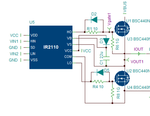bmakovecki
Newbie level 1
Hi
I'm trying to figure out how can I use IR2110 in my projects. I have couple of questions:
- Are R6,R8 mandatory? It doesn't seems to work properly at low freequency. I expect that when HIN is ON for 100ms, that vgate1 should stay ON for 100ms (time depends on bootstrap cap). But when using 1K R6,R8 gate stays opened for short time as it is drained away very quickly.
- When there is no load, high side MOSFET source is charged from VS and vgate1 compensate so that MOSFET VGS stayes at 0V. Is this expected behavior? If so, I do not like that VCC is leaking into high voltage circuit (bridge). Is there a way to prevent this? I would expect that when IR2110 powers ON and no load is present (all gates in bridge is closed) that all gates should be at 0V and no voltage is present on VOUT1.

Regards,
Boris Makovecki
I'm trying to figure out how can I use IR2110 in my projects. I have couple of questions:
- Are R6,R8 mandatory? It doesn't seems to work properly at low freequency. I expect that when HIN is ON for 100ms, that vgate1 should stay ON for 100ms (time depends on bootstrap cap). But when using 1K R6,R8 gate stays opened for short time as it is drained away very quickly.
- When there is no load, high side MOSFET source is charged from VS and vgate1 compensate so that MOSFET VGS stayes at 0V. Is this expected behavior? If so, I do not like that VCC is leaking into high voltage circuit (bridge). Is there a way to prevent this? I would expect that when IR2110 powers ON and no load is present (all gates in bridge is closed) that all gates should be at 0V and no voltage is present on VOUT1.

Regards,
Boris Makovecki

